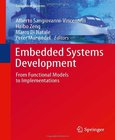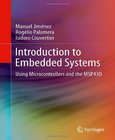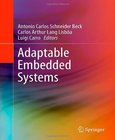Embedded eBooks Page 4
Download free Embedded eBooks Page 4
Embedded Systems Development
From Functional Models to Implementations
This book offers readers broad coverage of techniques to model, verify and validate the behavior and performance of complex distributed embedded systems. The authors attempt to bridge the gap between the three disciplines of model-based design, real-time analysis and model-driven development, for a better understanding of the ways in which new development flows can be constructed, going from system-level modeling to the correct and predictable generation of a distributed implementation, leveraging current and future research results....
Introduction to Embedded Systems
Using Microcontrollers and the MSP430
This textbook serves as an introduction to the subject of embedded systems design, using microcontrollers as core components. It develops concepts from the ground up, covering the development of embedded systems technology, architectural and organizational aspects of controllers and systems, processor models, and peripheral devices. Since microprocessor-based embedded systems tightly blend hardware and software components in a single application, the book also introduces the subjects of data representation formats, data operations, and programming styles. The practical component of the book is tailored around the architecture of a widely used Texas Instruments microcontroller, the MSP430 and a companion web site offers for download an experimenters k...
Software Test Attacks to Break Mobile and Embedded Devices
Address Errors before Users Find ThemUsing a mix-and-match approach, Software Test Attacks to Break Mobile and Embedded Devices presents an attack basis for testing mobile and embedded systems. Designed for testers working in the ever-expanding world of "smart" devices driven by software, the book focuses on attack-based testing that can be used by individuals and teams. The numerous test attacks show you when a software product does not work (i.e., has bugs) and provide you with information about the software product under test. The book guides you step by step starting with the basics. It explains patterns and techniques ranging from simple mind mapping to sophisticated test labs. For traditional testers moving into the mobile and embedd...
Adaptable Embedded Systems
As embedded systems become more complex, designers face a number of challenges at different levels: they need to boost performance, while keeping energy consumption as low as possible, they need to reuse existent software code, and at the same time they need to take advantage of the extra logic available in the chip, represented by multiple processors working together. This book describes several strategies to achieve such different and interrelated goals, by the use of adaptability. Coverage includes reconfigurable systems, dynamic optimization techniques such as binary translation and trace reuse, new memory architectures including homogeneous and heterogeneous multiprocessor systems, communication issues and NOCs, fault tolerance against fabricati...
Embedded SoPC Design
With Nios II Processor and Verilog Examples
Explores the unique hardware programmability of FPGA-based embedded systems, using a learn-by-doing approach to introduce the concepts and techniques for embedded SoPC design with VerilogAn SoPC (system on a programmable chip) integrates a processor, memory modules, I/O peripherals, and custom hardware accelerators into a single FPGA (field-programmable gate array) device. In addition to the customized software, customized hardware can be developed and incorporated into the embedded system as wellallowing us to configure the soft-core processor, create tailored I/O interfaces, and develop specialized hardware accelerators for computation-intensive tasks.Utilizing an Altera FPGA prototyping board and its Nios II soft-core processor, Embedded SoPC Desi...
2007 - 2017 © eBooks-IT.org





